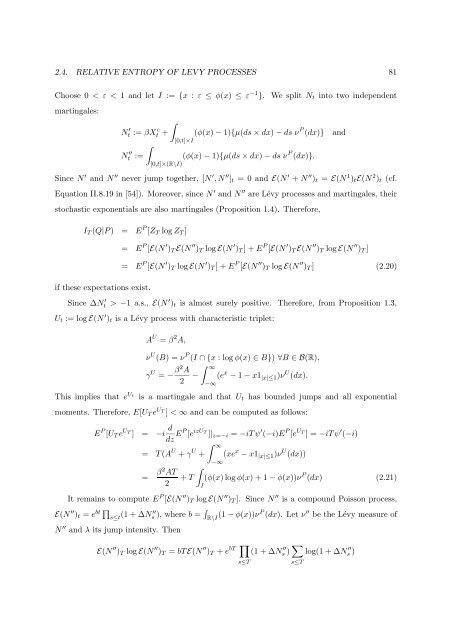Processus de Lévy en Finance - Laboratoire de Probabilités et ...
Processus de Lévy en Finance - Laboratoire de Probabilités et ...
Processus de Lévy en Finance - Laboratoire de Probabilités et ...
You also want an ePaper? Increase the reach of your titles
YUMPU automatically turns print PDFs into web optimized ePapers that Google loves.
2.4. RELATIVE ENTROPY OF LEVY PROCESSES 81<br />
Choose 0 < ε < 1 and l<strong>et</strong> I := {x : ε ≤ φ(x) ≤ ε −1 }.<br />
martingales:<br />
∫<br />
N t ′ := βXt c +<br />
[0,t]×I<br />
(φ(x) − 1){µ(ds × dx) − ds ν P (dx)}<br />
∫<br />
N t ′′ := (φ(x) − 1){µ(ds × dx) − ds ν P (dx)}.<br />
[0,t]×(R\I)<br />
We split N t into two in<strong>de</strong>p<strong>en</strong><strong>de</strong>nt<br />
Since N ′ and N ′′ never jump tog<strong>et</strong>her, [N ′ , N ′′ ] t = 0 and E(N ′ + N ′′ ) t = E(N 1 ) t E(N 2 ) t (cf.<br />
Equation II.8.19 in [54]). Moreover, since N ′ and N ′′ are Lévy processes and martingales, their<br />
stochastic expon<strong>en</strong>tials are also martingales (Proposition 1.4). Therefore,<br />
I T (Q|P ) = E P [Z T log Z T ]<br />
if these expectations exist.<br />
and<br />
= E P [E(N ′ ) T E(N ′′ ) T log E(N ′ ) T ] + E P [E(N ′ ) T E(N ′′ ) T log E(N ′′ ) T ]<br />
= E P [E(N ′ ) T log E(N ′ ) T ] + E P [E(N ′′ ) T log E(N ′′ ) T ] (2.20)<br />
Since ∆N ′ t > −1 a.s., E(N ′ ) t is almost surely positive. Therefore, from Proposition 1.3,<br />
U t := log E(N ′ ) t is a Lévy process with characteristic tripl<strong>et</strong>:<br />
This implies that e Ut<br />
A U = β 2 A,<br />
ν U (B) = ν P (I ∩ {x : log φ(x) ∈ B}) ∀B ∈ B(R),<br />
∫<br />
γ U = − β2 A ∞<br />
2 − (e x − 1 − x1 |x|≤1 )ν U (dx).<br />
−∞<br />
is a martingale and that U t has boun<strong>de</strong>d jumps and all expon<strong>en</strong>tial<br />
mom<strong>en</strong>ts. Therefore, E[U T e U T<br />
] < ∞ and can be computed as follows:<br />
E P [U T e U T<br />
] = −i d dz EP [e izU T<br />
]| z=−i = −iT ψ ′ (−i)E P [e U T<br />
] = −iT ψ ′ (−i)<br />
= T (A U + γ U +<br />
= β2 AT<br />
2<br />
I<br />
∫ ∞<br />
−∞<br />
(xe x − x1 |x|≤1 )ν U (dx))<br />
∫<br />
+ T (φ(x) log φ(x) + 1 − φ(x))ν P (dx) (2.21)<br />
It remains to compute E P [E(N ′′ ) T log E(N ′′ ) T ]. Since N ′′ is a compound Poisson process,<br />
E(N ′′ ) t = e bt ∏ s≤t<br />
(1 + ∆N<br />
′′<br />
s ), where b = ∫ R\I (1 − φ(x))νP (dx). L<strong>et</strong> ν ′′ be the Lévy measure of<br />
N ′′ and λ its jump int<strong>en</strong>sity. Th<strong>en</strong><br />
E(N ′′ ) T log E(N ′′ ) T = bT E(N ′′ ) T + e bT ∏ s≤T<br />
(1 + ∆N s ′′ ) ∑ log(1 + ∆N s ′′ )<br />
s≤T
















